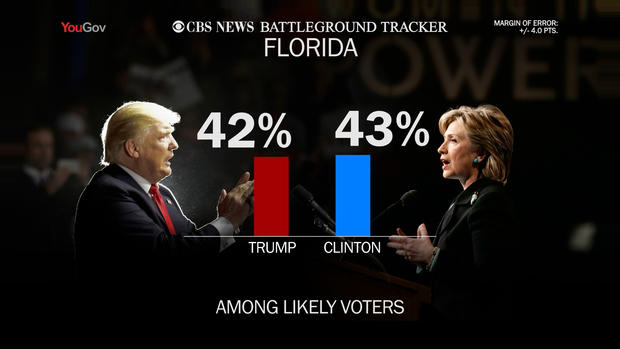CBS Battleground Tracker Poll: Ohio and Florida show tight races
By Anthony Salvanto, Fred Backus, Sarah Dutton and Jennifer De Pinto
Quadrennial battlegrounds Ohio and Florida start off as close races as the general election looms, helping describe a 2016 presidential race that looks to be very competitive.
Even as partisans appear to be coming into line behind their parties' likely nominees in these battleground states, many seem to be doing so begrudgingly, compelled by opposition to the alternative. And the wider electorate expresses both anger at the government and concern about the economy, just as primary voters did this spring. For them, the candidates' impending nominations elicit more cynicism than enthusiasm -- all of which could set the backdrop for a volatile, unpredictable contest.
In Florida, a hypothetical matchup between Democratic frontrunner Hillary Clinton and presumptive Republican nominee Donald Trump shows Clinton with a one-point edge among those with a preference, 43-42, and in Ohio, Clinton leads Trump by five at 44-39. A hypothetical matchup in Florida shows a tie between Democrat Bernie Sanders and Trump at 44 percent apiece, while in Ohio, Sanders enjoys a larger nine-point edge over Trump 48-39.
As a divisive primary season winds down and both Clinton and Trump face the inevitable questions about uniting their parties, at least eight in ten of their respective partisans are already preparing to back them -- even if it's only out of desire to stop the other side. Trump has at least eight in ten Republicans behind him in Florida and Ohio and Clinton has at least eight in ten Democrats behind her in both states.
But their ability to consolidate partisan support is helped, in part, by their opposition. Fifty-six percent of Clinton's voters in Ohio and 63 percent of her voters in Florida say their rationale is that she's the better candidate, but at least a third in both states are backing her mainly because she'd be the party's nominee or simply because they oppose Donald Trump.
It's similar for Trump -- fifty-four percent of his voters in Ohio say he's the better candidate than Clinton, while 30 percent of his voters are with him mainly to stop Hillary Clinton. That view is especially pronounced among the very conservative; the same type of voter who was often less likely to back him in primaries. In Florida, 60 percent of Trump backers feel they're choosing the better candidate and 29 percent are mainly voting against Clinton. A scant 11 percent are with Trump just because he's the Republican nominee.
Fewer than half of Republicans say it matters a lot to them whether their party "establishment" unites behind Donald Trump or not. This might not be surprising, since throughout the primaries Republican voters often voiced a lack of concern for what the establishment wanted.
But Trump does have more work to do wooing Republican voters in Ohio -- where he lost the primary -- than he does in Florida, where he won easily. Today he gets the bulk of Cruz and Rubio voters in Ohio, many of whom are with him largely to try to stop Clinton, but Trump does not get half of the voters who backed Governor John Kasich in the March primary; the other half of Kasich's backers remain undecided or for Clinton, and they're more likely to describe Trump's impeding nomination as concerning or scary, just as they did in exit polls this spring.
The primaries seem to have left the larger electorates a bit unsettled about the choices made by primary voters: while 61 percent of Republicans in Ohio are either excited or optimistic about the fact that the GOP is nominating Trump, 32 percent of Ohio voters overall feel as positive. And while 75 percent of Ohio Democrats are sanguine about the prospects of a Clinton nomination, just 40 percent of voters overall are optimistic or excited by it. Both candidates elicit negative favorability ratings overall: Clinton's are 55 percent unfavorable in Ohio even as she leads the race, Trump's are 59 percent unfavorable.
Bernie Sanders does better in Ohio among the same kinds of groups that have propelled him in the primaries: younger voters, and independents. He is also the only candidate of the three who has a net positive personal favorability rating, at 42 percent to 37 percent favorable, where Clinton's is 37 percent favorable to 55 percent unfavorable and Trump's is 32 percent favorable to 59 percent unfavorable.
One item that does carry over from the primaries to the general, though, is a larger sense of unease and dissatisfaction, especially over the economy. More than eight in ten Florida and Ohio voters are worried about the economy's direction. Across the primaries this spring, primary voters were also worried, and most Democrats and Republicans were in Ohio.
And that dissatisfaction may drive a different decision-making process: Today one-third of voters in each of the states - 36 percent in Ohio and 35 percent in Florida - say things in the country are going "so badly" that the country can "take a chance" in picking the next president. Republicans are especially likely to say this. Trump is leading handily among those voters statewide. Thirty-eight percent in Ohio and 42 percent in Florida say bad times mean the nation can not afford to take a chance, and Clinton has a lead -albeit a narrower one - among them.
On individual traits, Donald Trump's image does extend beyond the primary base, to mixed results. Trump greatly outdistances Clinton on ability to change Washington and tell it like it is (voters overwhelmingly think he'd do both) as he did in the primaries. In Ohio, 67 percent say he "tells it like it is" compared to 35 percent who say so about Clinton, and 69 percent say he would "bring change to Washington" while just 34 percent say that about Clinton. But 76 percent also say Trump can be "too extreme" at times in his views, something just 50% - most of whom are Republicans - say about Clinton. In Ohio women do hold somewhat more negative views of Trump overall than do men, 27 percent favorable to 37 percent favorable for men, but the difference in Florida between men and women is not as large, 36 percent for women and 40 percent for men.
Clinton outdistances Trump on preparedness to be commander-in-chief: Fifty-one percent say that about her, 33 percent in Ohio say that of him, and the numbers are similar in Florida. But Trump leads Clinton on approach to terrorism, specifically: in Florida 53 percent say he would be better to Clinton's 47 percent, and in Ohio Trump leads 51-49 on it.
You can find the methodology for these polls here:







